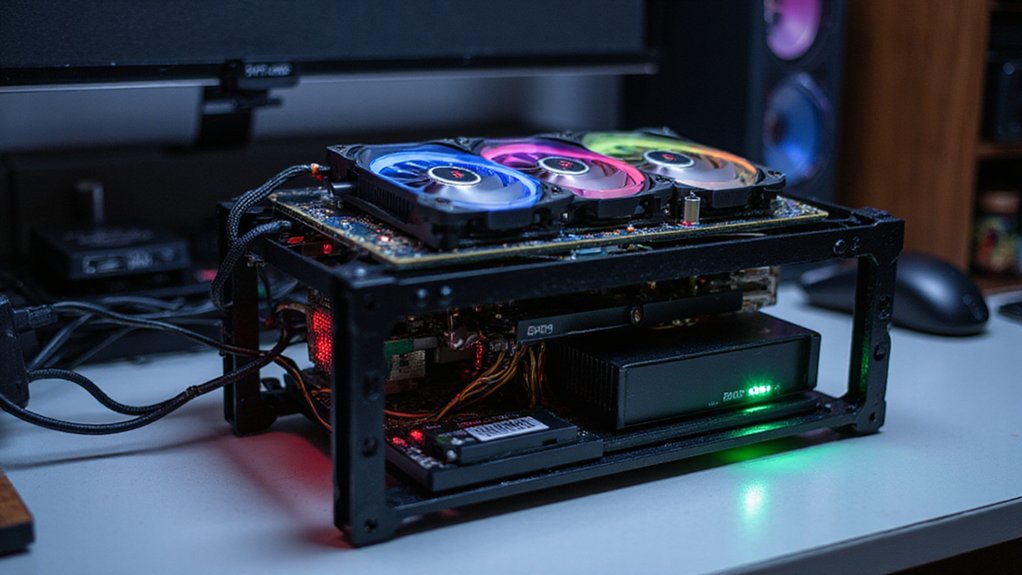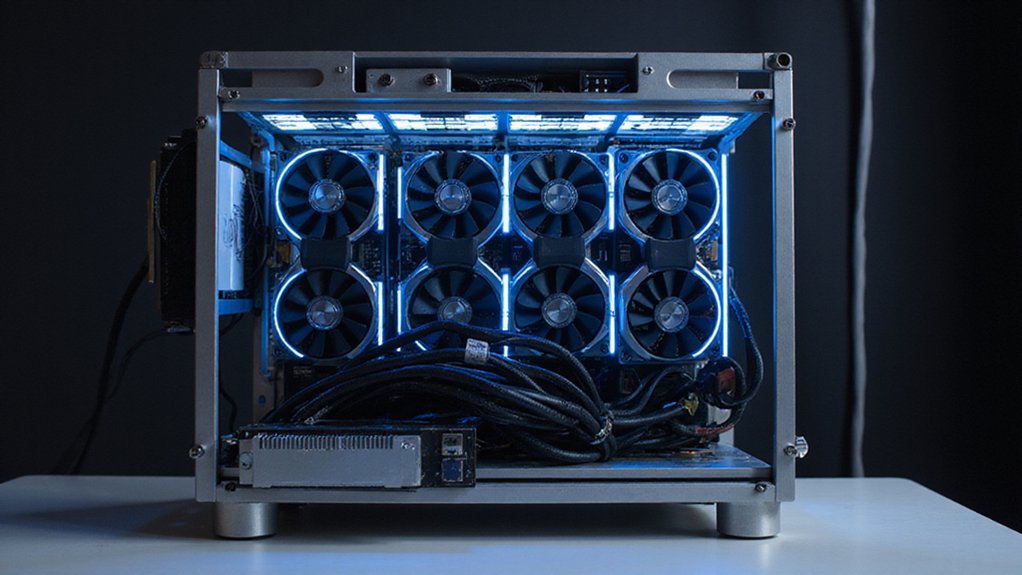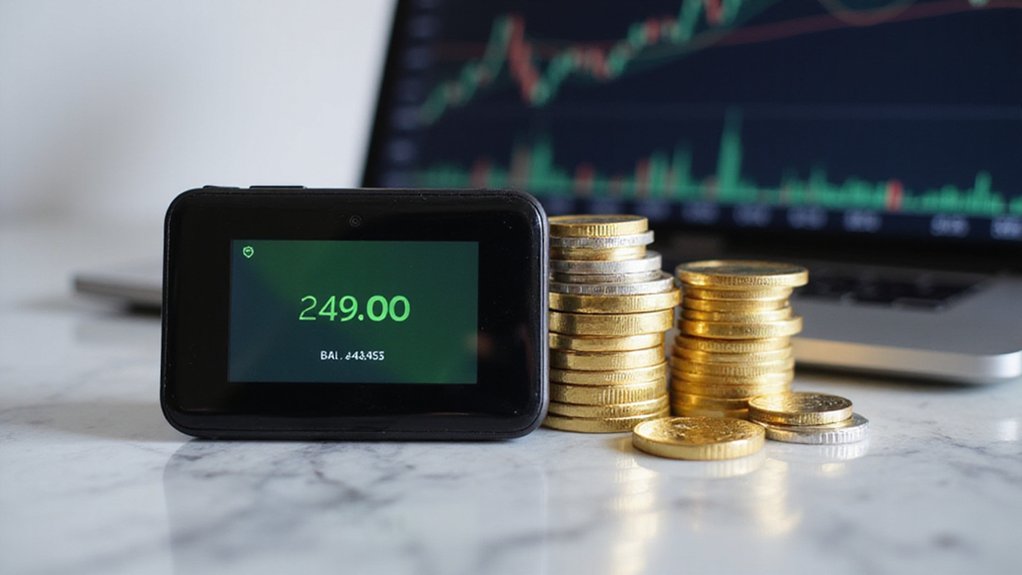Building a profitable cryptocurrency mining rig requires assembly of specific hardware components—multiple GPUs, compatible motherboard with sufficient PCIe slots, robust power supply, and cooling solutions—onto an open-air frame. The setup necessitates installing appropriate mining software like NiceHash, configuring a wallet address, and considering pool mining for consistent rewards. With initial investments ranging from $2,000-$10,000 and electricity costs potentially eroding profits, prospective miners should calculate ROI carefully before venturing into this technically demanding yet potentially rewarding domain.

Why do enthusiasts continue flocking to cryptocurrency mining despite its volatile profitability landscape? The allure of passive income generation—coupled with the techno-utopian promise of decentralized finance—creates an irresistible gravitational pull for those willing to navigate the considerable initial investment hurdles.
The siren song of crypto mining beckons with promises of financial autonomy—despite volatility lurking beneath its profitable surface.
Constructing a functional mining rig begins with component selection: multiple high-performance GPUs (the veritable workhorses of any mining operation), a compatible motherboard with sufficient PCIe slots (the ASUS B250 Mining Expert remains a perennial favorite), and a robust PSU capable of delivering 1300W or more.
One mustn’t neglect adequate storage—a modest 120GB SSD suffices—nor cooling solutions to mitigate the substantial heat generated during continuous operation. Many builders recommend installing heat sinks on GPUs, motherboard, and RAM components to ensure efficient heat dissipation during extended mining sessions.
Assembly follows a logical progression: mounting the motherboard onto an open-air frame (essential for thermal management), installing minimal CPU and RAM configurations (a basic Intel Celeron paired with 4-8GB RAM represents the cost-conscious approach), connecting GPUs via PCIe risers, and meticulously wiring the power supply.
The prudent builder conducts thorough component testing before proceeding further.
Software configuration demands equal attention. Either Linux or Windows provides a suitable operating system foundation, upon which specialized mining software (NiceHash or CGMiner, depending on one’s technical inclinations) must be installed.
A cryptocurrency wallet address—the destination for one’s hard-earned rewards—must be properly integrated into the configuration. Some miners opt for pool mining instead of solo efforts to increase their chances of earning consistent rewards despite having less powerful hardware.
Financial considerations loom large in any mining venture. Initial outlays ranging from $2,000 to $10,000+ (with GPUs representing the lion’s share) must be weighed against ongoing electricity costs.
Electricity costs, at $0.10-$0.30 per kWh, can rapidly erode profitability margins.
The savvy miner recognizes that ROI typically materializes within 12-24 months—assuming, of course, that cryptocurrency valuations maintain favorable trajectories and network difficulty increases remain moderate.
Maintenance cannot be overlooked: regular dust removal, temperature monitoring, driver updates, and hardware inspections constitute the minimum regimen for ensuring operational longevity.
The conscientious miner also maintains spare components, recognizing that downtime represents irretrievable opportunity cost.
These complex machines ultimately serve the critical purpose of validating transactions and adding them to the blockchain through solving cryptographic equations, contributing to the security of the entire network.
Frequently Asked Questions
How Much Electricity Will My Mining Rig Consume Monthly?
A mining rig’s monthly electricity consumption depends on several key variables: hardware specifications (with ASICs consuming 1,000-3,000 watts, GPU rigs somewhat less), operational hours (presumably 24/7 for most profit-minded miners), and cooling requirements.
One might calculate consumption by multiplying wattage by hours operated, then converting to kilowatt-hours.
A typical mid-range setup often consumes 500-1,500 kWh monthly—a fact that renders many mining operations economically questionable in regions with premium electricity rates.
Can I Mine Cryptocurrency on My Laptop or Smartphone?
Technically possible but practically imprudent, mining cryptocurrency on consumer devices represents the intersection of theoretical capability and economic folly.
While certain algorithms (Monero, Electroneum) accommodate CPU mining, the meager hash rates produced by laptops and smartphones yield rewards that rarely offset electricity costs—let alone account for accelerated hardware deterioration.
The thermal constraints of these devices further compound the issue, potentially reducing equipment lifespan through persistent overheating.
A curious experiment, perhaps, but hardly a viable income stream.
What Happens to Mining Profitability After Cryptocurrency Halvings?
Halvings—those periodic slashes to mining rewards—create a profitability crucible that separates the wheat from the chaff in mining operations.
Post-halving, miners face immediate revenue reductions (often 50%) while operational costs remain stubbornly fixed.
Historically, price appreciation has eventually offset these losses, though smaller operations frequently succumb before witnessing this recovery.
Survival hinges on three factors: operational efficiency, access to inexpensive electricity, and sufficient liquidity to weather the inevitable compression in profit margins.
How Loud Are Mining Rigs During Operation?
Mining rigs operate at considerable noise levels, with single ASIC miners generating 70-90 dB (akin to standing near a nightclub speaker—hardly conducive to neighborly relations).
The scaling follows logarithmic principles; a hundred machines might produce a headache-inducing 95 dB.
Modified setups with upgraded fans can reduce individual unit noise to 53-75 dB, while liquid cooling brings operations down to a more tolerable 50 dB range—still louder than most residential zoning permits would accommodate.
Do I Need Special Insurance for My Cryptocurrency Mining Operation?
Yes, specialized insurance is typically necessary for cryptocurrency mining operations.
Standard policies often exclude coverage for the unique risks miners face—electrical failures, hardware damage, and business interruption during market volatility.
Proper coverage should include property insurance for mining equipment, liability protection, and possibly business interruption insurance.
The scale of the operation, geographical location, and regulatory requirements will ultimately determine the specific insurance needs (and premiums, which—unsurprisingly—tend toward the astronomical).









